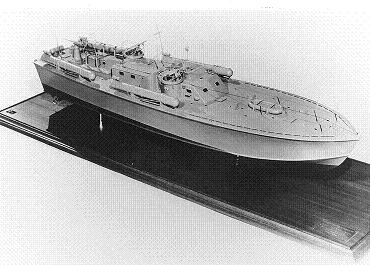![]() The Pacific War Online Encyclopedia
The Pacific War Online Encyclopedia
|
| Previous: Motor Torpedo Boat Tenders (PGM) | Table of Contents | Next: Mou Chung-heng |

Naval Historical Center #USN 1145017
Torpedo boats were introduced into the world’s navies prior to the First World War. They were small, fast boats with a low silhouette and a main armament of two to four torpedoes, intended to attack warships at night or other conditions of low visibility. The destroyer was originally a torpedo boat destroyer, armed with rapid-fire guns to protect larger warships from torpedo boats.
During the Second World War, most navies made use of motor torpedo
boats,
which were small, wooden-hulled
boats driven by internal
combustion
engines at
speeds of
40 knots or more. This was thought to give them the capability to attack by
surprise and then make good their
escape. However, their light
construction meant that they were highly vulnerable to aircraft during
daylight hours. Japanese seaplanes
operating off Guadalcanal in
January 1943 easily spotted the wakes of PT boats operating at night,
and the boats were vulnerable to aircraft around the clock thereafter.
The U.S.
Navy was enthusiastic about the motor torpedo boat concept
and built
hundreds of these craft for use in the South Pacific. They
proved to be a
disappointment in their original role, in part because of the miserable
quality
of U.S. torpedoes, and in part because the crews, mostly naval
reservists, were inadequately trained.
Hopes that PT boats could be effective as coastal defense ships were
dashed when it was found that the ships were simply too noisy and
unstable to make effective use of sound
gear.
However, the PT boats proved useful as small gunboats, and, later in the war, some even landed their torpedo tubes to make room for more guns and a measure of armor protection. PT boats became adept at hunting Japanese barges during the New Guinea campaign. Until late mid-1943, they were the only American warships that were risked in the poorly charted waters off the north New Guinea coast, and their presence put serious pressure on Japanese logistics.
The most important American success with PT boats against major warships was probably the 7 December 1942 action, when PT boats drove off a convoy attempting to bring supplies to the Japanese forces on Guadalcanal. The PT boats sank no Japanese ships, but the Japanese convoy commander was unwilling to run their gauntlet to complete his mission.
PT boats were also used for insertion of Alamo Scouts and other covert missions. The
ability of the boats to operate in darkness, their low silhouettes, and
their ability to muffle their engines by ejecting the exhaust
underwater (at some cost in performance) worked to their advantage on
these kinds of missions.
The Japanese Navy was one of the
few that made little use of motor torpedo boats. Japanese strategic
planners, who focused almost exclusively on the doctrine of Decisive
Battle, did not believe that these small craft could be effective in
the heavy seas near Japan, where the decisive battle was expected to
take place. By the time it became clear that they were fighting a very
different kind of war, the Japanese were late in the game and never
settled on a balanced design that could be mass-produced. The Japanese
finally turned to suicide motor
boats instead.
References
Goldstein and
Dillon (1993)
Nelson (1998)
The Pacific War Online Encyclopedia © 2007-2009 by Kent G. Budge. Index